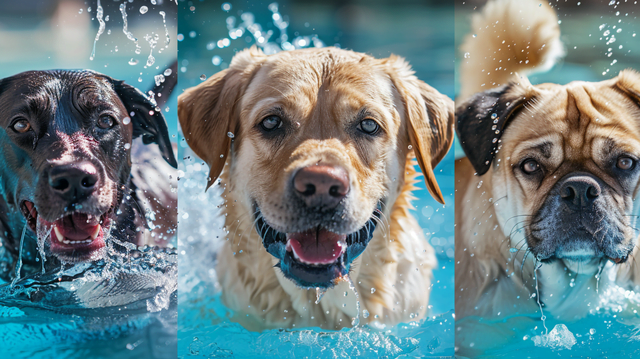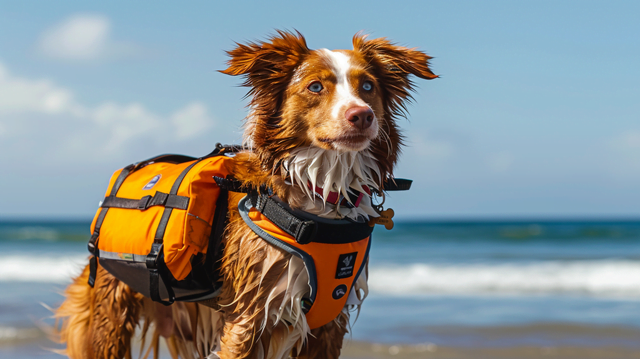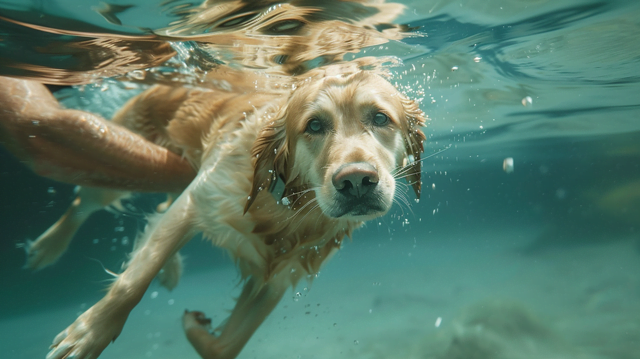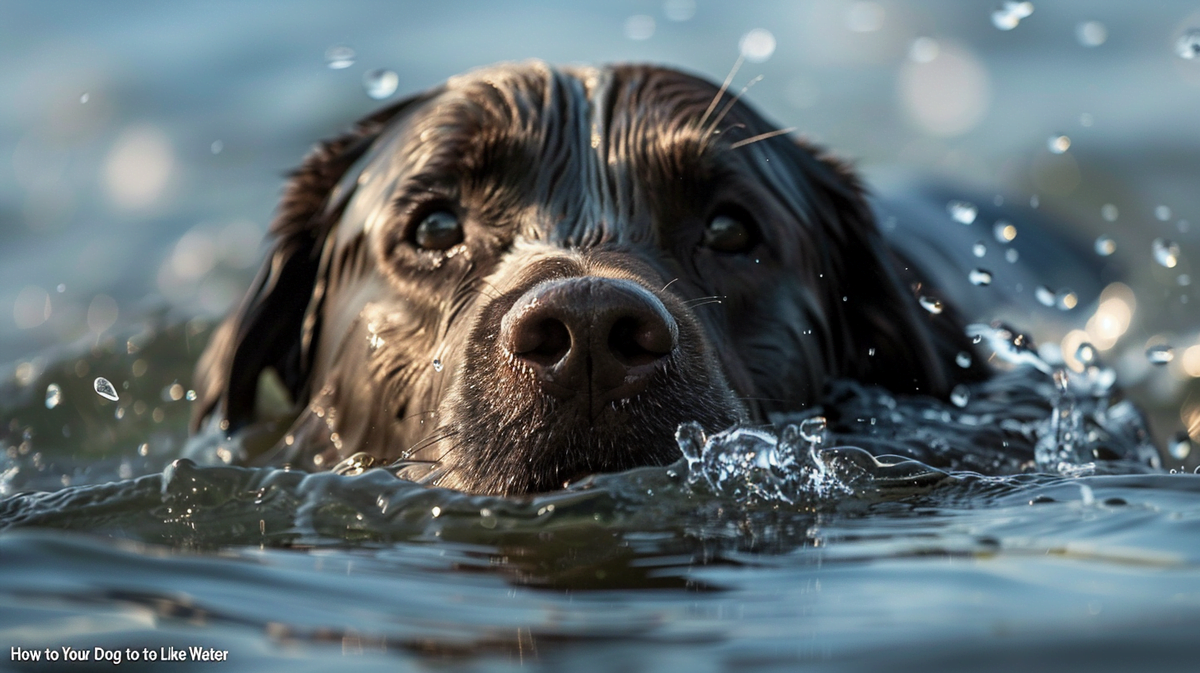Hey there, dog lovers! Is the thought of your pup diving into a lake, splashing in the ocean, or frolicking by the pool just a distant dream? Well, don’t throw in the towel just yet! While some dogs are born swimmers, others might need a bit more convincing before they’re ready to take the plunge. But with some patience and a whole lot of fun, you can help your four-legged friend learn to enjoy the refreshing world of water.
The Benefits of Getting Wet and Wild
Before we dive into the how-to’s, let’s talk about the perks of having a water-loving pup. It’s not just about beating the summer heat! Swimming is paw-sitively amazing for your dog’s health in so many ways:
- Low-Impact Exercise: Perfect for active buddies and senior pups alike. It puts less stress on their joints than other forms of exercise.
- Cardio Boost: Strengthening your dog’s heart and lungs is great for their overall fitness and well-being.
- Weight Management: If your pup is packing a few extra pounds, swimming can be a fun way to burn calories.
- Mental Stimulation: It’s not just about physical benefits! Playing in water is mentally engaging for dogs and can help tire them out in a good way.
Why Some Dogs Say “No Way!” to Water
Now, let’s address the big question: Why do some dogs steer clear of water like the plague? There are a few common reasons:
- Bad past experiences: Think forced bath time or a scary run-in with a wave. These can lead to a lasting fear of water.
- Breed instincts: Not all dogs are built for swimming. Short-legged breeds like Dachshunds or brachycephalic breeds like Bulldogs have a harder time staying afloat.
- Simply a mystery: Maybe your pup just never had the chance to explore the joys of water during those crucial puppy months!
Expertise, Experience, and Fun!
And guess what? You’ve got an experienced guide (that’s me!) to help you navigate these waters. I’m a dog enthusiast with a soft spot for those pups who need a little encouragement. Through my own experiences and a bit of research (because you can bet I’ll be citing some reliable sources), I’m going to share tips and tricks to make water a source of fun, not fear.
Does Your Pup Have a Water Woof-Q?
We all know each dog is a unique bundle of personality. Some pups fetch balls with the zeal of an Olympic athlete, while others prefer a cozy nap on the couch. The same goes for water! Before we start tossing water toys, it’s helpful to figure out your dog’s “Water IQ.”
Fun Quiz Time! Let’s have some fun and discover your dog’s inner water spirit. Answer these simple questions:
- Does your dog chase the sprinkler with wild abandon?
- When passing a lake or beach, do their ears perk up and their tail start wagging?
- Are bath times a full-on wrestling match?
- Have you ever caught them curiously lapping water from a puddle?
If you answered mostly “yes”, you might have a natural-born swimmer on your hands! If mostly “no”, don’t worry – with some positive reinforcement, any dog can learn to love (or at least tolerate) water.
Breed Basics
While every dog is one-of-a-kind, we can’t deny that breed does play a role in how comfortable a dog is around water.

Here’s a quick breakdown:
- The Aquapups: Breeds like Labrador Retrievers, Newfoundlands, and Portuguese Water Dogs are practically born with flippers!
- The Cautious Cuties: Dachshunds, Basset Hounds, and Bulldogs, with their short legs and stocky bodies, might need extra support and encouragement.
- The “Maybe, Maybe Not” Crew: This is where most dogs fall. They might need a bit of coaxing initially, but with practice can become confident splashers.
Reading Your Dog’s Body Language
Dogs are experts at telling us how they feel, we just need to learn their language! Pay attention to these signs when your dog’s around water:
- Eager Explorer: Perked ears, wagging tail, maybe even a playful bark – this pup is ready for an adventure!
- The Worried Whimperer: Whining, trembling, or trying to hide means they are feeling scared or anxious. It’s time to back off and try another day.
Remember: Never force a fearful dog into the water. This can make their anxiety worse.
Safety is No. 1 – Always!
Before the splashing fun begins, it’s crucial to keep safety top of mind. Nobody wants their dog’s water adventure to turn into a scary situation! Here’s a checklist for ensuring your pup is safe and happy:
Location, Location, Location
- Calm and Shallow: Start in a calm body of water with a gentle slope for easy entry and exit. Small pools, quiet beaches, or even a designated dog park with water features are good choices. Avoid rushing rivers or areas with strong waves.
- No Hidden Dangers: Make sure there’s nothing lurking beneath the surface, like sharp rocks or strong undercurrents.
- Supervised Fun: Never leave your dog unattended near water, even if they seem like a confident swimmer.
Gear Up for Water Adventures
- Life Jacket Love: This is a must-have, even for strong swimmers! A well-fitting life jacket provides extra buoyancy and has a handle on the back for quick rescues if needed.

- Sunscreen and Shades: Yup, dogs can get sunburned too! Apply dog-safe sunscreen, especially to sensitive areas like noses and ears. Consider doggie sunglasses if your pup squints in bright light.
- The Comforts of Home: Bring along a familiar, absorbent towel for drying off and a portable water bowl to stay hydrated.
Beat the Heat in Style
Speaking of sun, let’s not forget the dangers of overheating, especially for our furry friends. Follow these tips to keep your pup cool:
- Timing is Everything: Take water breaks in the shade, especially during the hottest parts of the day.
- Watch for Warning Signs: Excessive panting, drooling, weakness, or confusion are signs of heat stress. Get your dog to a cool area and offer water immediately.
- Gradual Acclimation: It’s important to get your dog used to different water temperatures slowly to avoid shock. Start with warmer water and build up to cooler temperatures on hot days.
Let the Water Games Begin!
The secret to helping your dog overcome a fear of water? Make it fun! Think of it like introducing a kid to a new food – positive experiences make it much more enjoyable.
Dealing with Specific Fears
- The Sound of Splashing: Fill a kiddie pool or shallow pan with water and let your dog investigate it at their own pace. You can even use a watering can to mimic the sound of waves, starting gently and getting a bit more “splashy” as your dog gets comfortable.
- Mystery Texture: If the feeling of water is strange to your pup, create a “splash zone” with a sprinkler on a low setting. They can ease in without getting completely soaked at first.
- All About the Treats: Lure your dog closer to the water’s edge with a trail of tasty treats. Be patient! Even a single paw dip is progress!
Toys Make Everything Better!
Water-loving toys are a game-changer! Here’s why:
- The Power of Play: Dogs naturally love to chase and retrieve. Floating toys tap into that instinct in a new environment.
- Floating Fun: Opt for toys designed to float. Start by tossing them just a bit out of reach in shallow water so your dog doesn’t have to fully submerge.
- DIY Options: Frozen Kongs filled with peanut butter or treats inside empty water bottles make inexpensive and enticing water toys.
The Buddy System Can Work Wonders
Do you have a friend with a dog who’s a champion swimmer? Seeing another dog having a blast in the water can sometimes be the best encouragement for a reluctant pup.
Important Note: Make sure both dogs are friendly, and always supervise them. Start with having your dog observe from afar before letting them mingle near the water.
Celebrate Every Tiny Win!
This is all about building confidence. Reward your dog with tons of praise, a special treat, or a favorite game even if they only dip their paws in or look curiously at the water. Make them associate water with happy, positive things!
From Puppy Paddle to Pro Swimmer
Once your dog is comfortable being around water and playing in the shallows, it’s time for the next step! Just remember, patience is key, and every dog learns at their own pace.
Safety: It’s Still Top Priority
- Life Jacket Support: Always use a properly fitted life jacket, especially when practicing swimming skills.
- Your Helping Hand: Support your dog’s chest or belly (depending on their size) while they first learn to paddle. This gives extra security and boosts confidence.
Swimming 101 – The Basics
- Start Shallow: Stay in water where your dog can stand if needed. Gradually move to slightly deeper water as confidence grows.
- Follow the Treats: Use floating treats or a toy to lure your dog further into the water. Gently encourage them to paddle their paws to reach it.
- Praise the Paddle: Every little doggy-paddle deserves celebration! Positive reinforcement makes learning fun.
- Short and Sweet: Keep training sessions brief and positive, especially in the beginning. Pushing a tired or anxious dog can lead to setbacks.
When to Seek Professional Help
If your dog shows extreme fear of water or you’re simply not making progress, don’t hesitate to seek help from a certified dog trainer. They can offer personalized techniques and address any underlying behavioral issues.

Level Up the Water Fun!
Once your dog is a confident swimmer, the possibilities are endless! Here are a few ideas for adventurous water-loving pups:
- Dock Diving: Does your dog love to fetch? Dock diving is a thrilling sport where dogs launch themselves off a dock into a pool in pursuit of a toy. (Start with low heights and professional training!)
- Paddleboarding with Your Pup: With practice and the right gear, some dogs enjoy relaxing on a paddleboard while you do the paddling. Start in very calm water!
- Boat Rides: If you’re a boat owner, introduce your dog to the joys of boating with proper safety gear and short trips at first.
- Water-Focused Games: Play fetch with floating frisbees, try a floating agility course, or set up a water obstacle course in your backyard with sprinklers and pools.
Brain Boost and Water Play
Water activities aren’t just about physical exercise; they offer great mental stimulation too! This is especially important for those breeds always up for a challenge.
- Floating Puzzle Toys: These force your pup to think strategically to get the treats inside.
- “Find the Toy” Games: Toss a toy into the water and encourage your dog to locate it, rewarding them when they bring it back.
Important: Always choose activities that suit your dog’s personality and skill level. Safety and enjoyment come first!
Conclusion
Remember, whether your dog becomes a champion swimmer or simply enjoys a refreshing dip on a hot day, the most important thing is having a positive, fun experience! Take things slow, be patient, and celebrate every splash along the way. Who knows, you might just discover a hidden passion for water within your furry friend.
Do you have a success story about your dog overcoming their fear of water? Or maybe a funny anecdote about a water-related mishap? Share them in the comments below! We love to hear about your adventures and learn from each other.
FAQs
How do I teach my dog to like water?
The key is patience, positive reinforcement, and making it fun! Start slowly in shallow water, use lots of praise and treats, and focus on games with water-loving toys. Gradually increase the depth and always respect your dog’s boundaries. If they seem scared or anxious, take a break and try again later.
At what age can I start teaching my puppy to swim?
Most puppies can start exploring water around 8-10 weeks old, but focus on shallow, supervised play at first. True swimming skills typically develop later, depending on the breed. Always use a puppy life jacket and prioritize their comfort and safety.
What are the best water toys to encourage a reluctant dog?
Choose toys that float and are brightly colored for easy visibility. Fetch toys that bounce erratically on the water’s surface can be especially enticing. Some good options include squeaky rubber balls, floating frisbees, or even DIY water toys like frozen peanut butter Kongs.
How do I know if my dog is too tired while swimming?
Watch for signs of fatigue like excessive panting, slowed movements, shivering, or seeming disoriented. Encourage frequent breaks in the shade with fresh water. Remember, swimming is a great workout, but too much can be harmful, even for strong swimmers.
My dog is terrified of bath time – will this translate to a fear of all water?
It’s possible, as negative experiences can create a lasting association. However, you can overcome this with slow desensitization. Start by making the empty bath a positive space with treats and toys. Gradually add tiny amounts of water and work your way up to full baths over multiple sessions, always using lots of praise.
Can water activities help my overweight dog lose weight safely?
Absolutely! Swimming is a fantastic low-impact exercise for overweight dogs, as it puts less stress on their joints. Consult with your veterinarian to develop a safe exercise plan that incorporates water activity along with appropriate diet changes.
How do I keep my dog’s ears from getting waterlogged during swimming?
While some breeds are more prone to ear infections, you can help keep all dogs’ ears healthy after swimming. Gently dry the outside of their ears with a soft towel. Ear cleaning solutions designed for dogs can be used if your vet recommends them. Watch for signs of infection like redness, swelling, or discharge, and consult your vet if you’re concerned.

My job is to make sure every fact is right and every article is a joy to read. I’m kind of like a dog trainer for information – I make it behave!


